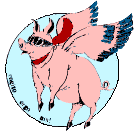One miracle of my childhood was the crystal radio, of which we owned several. My brother built one for a Boy Scout merit badge project, using a Quaker Oats box (to wind the copper coil on), a cigar box (as a case), a long aerial wire and some purchased components—a crystal and a cat’s whisker with posts to connect the aerial and a headphone jack. We also had a store-bought unit, no more complex or elegant than my brother’s. Frequently, I sat late at night (when ionospheric bouncing worked best) seeking distant, powerful radio stations. This minor obsession was 20 years past its due date: growing up in the Age of Television, I played at a hobby that peaked ca. 1920, the era of crossword puzzle obsessions, flagpole sitters, wing-walkers and bathtub gin artistes.
Donning our old headphones made me feel like Smilin’ Jack, and hunching over the little crystal set and delicately scratching the tip of the cat’s whisker on the surface of the tiny crystal diode was like a sinister scene from a novel by E. Philips Oppenheim (my father had a shelf full) or a movie by Alfred Hitchcock. I pictured myself in an attic in Occupied France, receiving encrypted messages from the
The crystal radio was miraculous because it was so simple. It ran without a power source, and its operation—like God’s—was inscrutable. No labeled switches and knobs, no lighted dial with scales for tuning—AM, FM, short wave. The crystal diode was a little jewel-like lump encased in a bit of metal (it looked like a metal molar with a diamond filling), and the cat’s whisker was a tiny copper coil on an arm that swiveled. You lowered the end of this wire to the crystal and moved it until you heard a signal through the headphones—voices or music. You carefully left the cat’s whisker alone and listened. The signal wavered and might evaporate, given atmospheric conditions and other esoterica. The signal filtered through a scrim of static, and you had to listen hard to sort cosmic chaff from kernels of sound.
Some nights the search for viable signals was fruitless—a station emerged briefly, one not remote or exotic,
The equipment was so primitive and sensitive it made the routine boringly simple: I found a station coming in strongly and listened, regardless of the program, until I heard a station break naming the station and its location. If I had been an utterly obsessed listener, like many radio hams, I would have kept a log and entered the data—date, time, duration, program—for some imagined historical, anthropological or autobiographical purpose. But I never spent time and energy on ephemera. I was only interested in the moment—the magical instant of contact with a regional dance band in a nightclub atop a fancy hotel in St. Louis or Des Moines or Tulsa or a newscaster in Milwaukee reporting a warehouse fire or a baseball game from Cleveland dying in extra innings.
The charm of the crystal radio was purely existential—it was in and of the moment, capturing live AM radio as broadcast, before tape delays and other such flummery. Transcription broadcasts existed, mostly daytime features or canned music. In the cold night, everything was alive, frosty and distant, here and gone in seconds—now you heard it, now you didn’t. The thrill was capturing one evanescent instant never to be recreated. With the twitchy little cat’s whisker and homemade antenna, reception was touch and go, a cosmic crapshoot.
Listening was like spying or eavesdropping, catching a wisp of strange music, a mysterious conversation, the inexplicable middle of a cliff-hanging melodrama. I listened for clues to the station or locale, regional accents, oddities of culture. Southern stations advertised “headache powders,” nostrums alien to me in the
From the southwest came western swing or rough-voiced cowboy singers plus religious fundraising from renegade mega-stations across the
............I picked up slick urban stations and country outfits that transmitted pure corn, segueing without transition. I found barn dances in
My history with the crystal radio spanned a few years, but we always had good radios in the house, including an odd Chinese Chippendale box my parents called “the Old Radio,” converted to a liquor cabinet. It was a mock-ebony sideboard on twisty baroque legs, with clever sliding doors. It took me years to realize it was the fancy case for an early console, once equipped with earphones and a horn speaker like the business end of a trombone. The guts were long gone, but I imagined my parents as young people (a stretch) sitting around the horn, doing what I did with my $1.25 worth of crystal radio. Radio pioneers in ancient Marconi days, twiddling a dial, twitching the aerial wire and hoping for golden sounds through the haze of static. It welded me to my family, at the instant when TV barged through our door to murder radio-listening as a family activity.
I don’t remember how or why I took up the crystal radio—simply because it was there or because I already listened to a bedside portable radio for an hour or so after lights out. The little apparatus required diligence and skill and imparted a cheap thrill at snatching a signal from the empty sky.
............I have no idea where the radio went—given away or heaved into the trash—and I don’t know if kids today would glance at such an oddity. It was an elegant low-tech device that might not even register as technology—the obverse of Arthur C. Clarke’s Law. It was do-it-yourself magic from an era when do-it-yourself meant that, when hardware stores and radio shops flourished and a simple schematic (25 cents from Popular Science) propelled you to the stars or to the Arcadia Ballroom in
 Copyright 2007 All Rights Reserved
Copyright 2007 All Rights Reserved

| jptArchives |